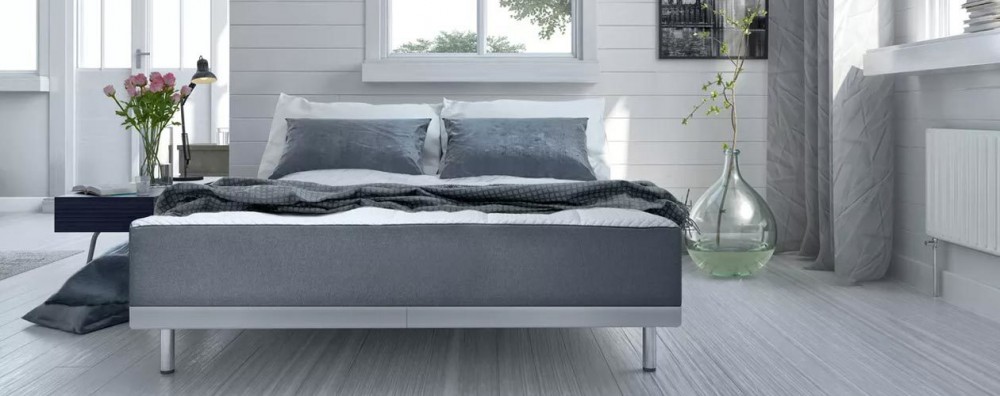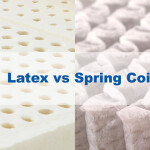Memory Foam vs. Latex Mattress
If you are in the market for a new mattress, you are in luck. Today, consumers have a near-unending assortment of choices — each claiming to guarantee your best night’s sleep ever. These mattresses are usually made of some type of compress foam or rubber. With an onslaught of advertisements, many of which are spun in an irreverent and comical manner, it’s hard to miss the fact that mattresses are a big deal.
data-ad-client="ca-pub-1542090382626399"
data-ad-slot="7742579998">
The Mattress Market is Huge
There are an estimated 100 different companies selling mattresses online. This doesn’t count the dozens of traditional innerspring mattress makers that also dabble in the newer foam technologies. The online bed-in-a-box makers have revolutionized the mattress industry. While foam beds have been around for many years — so-called “memory foam” technology was developed in the 1970s by NASA as a material for astronaut seating — the last five or six years have seen the market explode with options.
With all of the mattress choices today, buying a bed can be extremely confusing. Just a few years ago, shopping for mattresses meant driving to the furniture or mattress store, hopping a few display models and picking the one that was most comfy. Now, you can order one from your smartphone, unzip it from a vacuum-sealed bag, and watch it spring to life in your bedroom. The idea of a king-sized mattress landing on your doorstep in a surprisingly small cardboard box still seems unreal.
Different Types of Mattresses
There are generally two types of popular mattresses today: traditional innerspring and compressed foam. There are some other choices, such as waterbeds and coco mattresses, but most people are either looking for the diverse support options found in innerspring or foam mattresses.
Innerspring Construction
Most people are aware of traditional innerspring mattresses. You likely spent most of your sleeping life on one. These are made of tightly wound coils surrounded by a cushioning mixture that can combine a variety of materials. While traditional mattresses can provide a quality sleeping experience, they fail in several areas, such as durability and comfort.
Compressed Foam
The new breed of sleep comfort is all about foam. Foam mattresses provide unparalleled support and comfort. Most foam mattresses conform to your body, so you avoid pressure points. Many refer to this as memory foam, but there are actually two types of compressed foam: memory foam and latex. Out of the 100 or so bed-in-a-box manufacturers, most are memory foam, but there is a growing number of latex mattresses.
What’s the difference between these two? Aren’t all foams the same? These are the questions that we set out to answer to help make your bed shopping easier. Let’s start with a closer look at each type of foam mattress construction, then we’ll look at the pros and cons of each type based on the most common sleep benefits.
Memory Foam Mattress Construction
Memory foam is mostly made of polyurethane, although other chemicals can be used to change its qualities. During construction, polyurethane foam, a synthetic product, is whipped up, and formed into a sponge-like mass. Other chemicals are added to give the foam a springy but resilient feel.
One of the hallmarks of memory foam is its ability to mold to a body, then spring-back to its original position when unoccupied. Conventional innerspring mattresses provide cushioning and a small amount of molding to the body, but over time these mattresses lose the ability to spring back into shape. Memory foam retains spring-back for a much longer period.
Memory foam mattresses are popular. Not too long ago, these were considered high-end mattresses that were only available from a handful of sellers. Now memory foam is available everywhere. In addition to the many online outlets, memory foam mattresses are in furniture stores, mattress shops, and even discount retailers.
Memory Foam Brands
Some of the popular memory foam brands include:
- Puffy
- Muse
- DreamCloud
- Casper
- Layla
- Loom & Leaf
- Nectar
- Plushbeds
There are, of course, many more options to choose from when it comes to memory foam. In addition to these top brands, some of the best-known names in bedding also offer memory foam options, such as Sealy, Serta and Sleep Number.
Memory Foam Price Range
Mattress price range depends on several factors. Size, of course, is a major factor. A king mattress requires a lot more material than a twin model. For our comparisons, we looked at queen-sized mattresses since all manufacturers offer this size option and it may be the most popular choice.
On the lower-priced end of the spectrum, a Serta 8-inch plush memory foam mattress can cost under $500. A premium, high-quality bed, such as the Plushbeds 12-inch Heavenly Plush model retails for around $1,700.
Latex Mattress Construction
A latex mattress is similar to memory foam, but instead of a sleeping experience where compressed foam envelopes you, latex is springier and more responsive. This is because of the qualities of latex — a type of natural rubber. That is not to say that all latex mattresses are natural or made of natural materials.
Natural latex comes from the rubber tree plant. Rubber trees are indigenous to the Americas — more specifically Central and South America. The Amazon rainforest is home to rubber, as are the areas where the ancient Mayan civilization flourished. While the first applications of rubber are well known, such as rubber bands, pencil erasers, sports balls, shoe soles, tires and latex gloves, latex eventually became a mattress material.
To further complicate the mattress buying process, latex mattresses come in two main construction types: Dunlop and Talalay. Dunlop is a ages-old process of creating and molding rubber. It starts with tapping rubber trees, then involves cleaning and heating the liquid latex in molds. Talalay is similar to the Dunlop method, but adds small spaces in the mold, resulting in a perforated latex mattress that allows for air flow.
One might think that a rubber mattress would be somewhat strange. Rubber may seem more fit for a pool float than a furniture component, but modern latex mattresses use a rubber core technology surrounded by plush elements, such as fabrics and non-rubber cushions. The resulting sleep experience is firmer than memory foam, but not at all like sleeping on a bouncy ball.
Latex Mattress Brands
Some of the popular latex mattress brands include:
- Avocado Mattress
- My Green Mattress
- Lucid
- Brentwood Home
- Zenhaven
- PangeaBed
Latex Mattress Price Range
Latex, especially the natural variety, can be expensive when compared to memory foam and other mattress material options. There are bargains in the mix, though, such as the Lucid 10-inch latex mattress, which costs around $550. Prices for other brands range from around $1,000 for a queen-sized model from MyGreenMattress, to up to $4,000 for a premium model at a furniture store. Most online bed-in-a-box options cost around $1,500.
Comparison Between Memory Foam and Latex
Based on the information we’ve gathered so far, you may be thinking, memory foam provides cheaper options and latex is across the board fairly expensive. But there is much more involved in solving your optimal sleep equation. Although each of these products is similar, there can be vast differences when you get to the minute details.
When it comes to sleep, remember that price is only one consideration among many. We spend one-third of our lives on our mattresses, so finding the right material and fit for you (and your partner) is a crucial component to a happy and healthy life.
We should note also that almost all mattress brands, especially those that sell online, provide for a free trial period, such as 100 nights. Some brands stretch this to a full year. These manufacturers are likely banking on the fact that most people will not take advantage of these free trial period offers since there is likely at least some amount of hassle involved in making a return.
Still, the free trial period can help those who are undecided and fearful that they might have to commit to a bad choice.
If you have made the decision to look at a foam bed, rather than a conventional innerspring mattress, here is everything you need to know about the differences between memory foam and latex.
Comfort Considerations
Both memory foam and latex mattresses are designed for optimal comfort and come in various degrees of firmness and support. Comfort is a highly subjective concept. The best support for a side sleeper may differ from that of a back sleeper.
A larger person may need more support than a child, and people with back issues may find one type of foam to be better for their needs. In rating comfort, we collected some of the commonly received feedback on the different materials to come up with some general guidelines.
Memory foam provides a sensation of being suspended in a block of foam. A very soft style of memory foam with little support can feel a bit like you are sleeping in quicksand. These low-support models may be difficult to climb out of in the morning. Imagine rolling over a bit too far and getting lost in the midst of the center of such a quagmire.
Luckily most memory foam mattresses provide sufficient support to balance out the cushion. The resulting experience is soft and conforming, while responsively supportive.
Latex’s comfort is all about response. Its faster response time means that the sleep experience is bouncier than both innerspring and memory foam. Latex mattresses provide less “hug” — the conforming feel of foam mattresses. While there is a good deal of compression into the mattress from your body, it is much less specific to your shape than memory foam.
Temperature
One of the biggest differences between memory foam and latex relates to sleeping temperature. Some people avoid foam mattresses because of their bad reputation as heat traps. A traditional innerspring mattress has a lot of air in it — scattered around the loose material and metal coils. These spaces allow for air flow.
A foam mattress might have much less air, and the main materials tend to absorb body heat. If the foam reaches your body temperature, you can have a horribly sweaty night’s sleep.
Most foam mattresses use a variety of techniques to minimize trapped heat. But there is only so much that can be done for certain materials. Latex tends to run cooler than memory foam. This is especially the case with Talalay latex, which has air added to create a less dense mattress that has built-in breathability.
Some of the cooling technologies used by memory foam mattresses to reduce temperature include perforated top layers to separate your body from the hottest foam, and cooling gel layers to draw heat away from your body and the mattress top.
Pain Relief
Just as with general comfort considerations, pain relief is an individual question. Memory foam’s ability to hug the sleeper creates a pressure point-free sleep experience. When floating in a sea of foam, your body naturally aligns, which can greatly reduce lower back and hip paint.
Latex mattresses can also provide the soft give that helps in spinal alignment, but since the experience is more general and not targeted to every inch of the sleeper’s body, you may experience more support than cushion with rubber.
Support, however, may be exactly what you need to avoid pain. A too-soft sleep experience can be too much for some sleepers, causing pain because the body is allowed to sink. Lack of support in a too-soft bed can actually be much more uncomfortable in the long run. This may be one area where a latex bed might have a leg-up on the competition. With latex, you experience softness with a big dose of responsiveness.
For those with back pain, a soft bed is often far from ideal, with a medium-firm support often being the best choice. Both latex and memory foam offer medium-firm support.
Edge Support
Another consideration when choosing between memory foam and latex mattresses is edge support. Edge support is how a bed feels when you are sitting on its edge. If you often sit on your bed, such as if you like to watch TV from a sitting position, or if you tie your shoes each morning from the edge of the bed, then this might be a major concern.
People most often deal with edge support when they attempt to get up in the morning. A mattress with insufficient edge support is going to be a chore to escape from, while the perfect amount of support will feel like a quality traditional bed.
Edge support is usually best in firmer mattress models. But there can be a need to balance support, comfort, pain relief and ease of navigation. A mattress may feel great once you are laying in it, but if getting in and out of the bed is a struggle, you can negate the comfort benefits quite quickly.
In general, memory foam often has less edge support than latex mattresses, but there are some memory foam models that include additional support features to minimize this problem.
Durability
When you invest in a mattress, you want to maximize the product’s life. A cheap mattress may be a bargain today, but if discomfort or lack of durability drive you to replace it in a few years, you can end up spending more than if you paid a little more at first.
When it comes to durability, memory foam and latex are mostly neck and neck. Some say that latex’s increased bounce make it stand up to more abuse, but only the cheaper memory foam models tend to suffer from build quality concerns and lack of longevity.
For even less than the expense of a typical latex mattress, you can find a memory foam mattress built to last. Either way, both a memory foam and a latex mattress will easily outlast traditional innerspring mattresses, which have coils that become compressed over time.
Mattress Odor
If you’ve done any research on foam mattresses, you may have come across the term “off-gassing.” Off-gassing is a byproduct of foam production, be it natural, as in a latex mattress, or the synthetic odor of a memory foam model. When you unzip your new mattress, you will be treated to a nice whiff of something a bit odd. The good news is that over time, usually a few days or weeks, the odor will disappear.
Some people are more sensitive than others to these odors. Luckily there are two easy ways to eliminate the smell, regardless of the type of construction. First, air the mattress out for as long as you can. Open windows if it’s not too cold, and turn on the fan. Second, look for a mattress with a quality natural-fiber cover, which will often filter out the smell.
An Additional Choice Provides the Best of Both Worlds
Confused about which mattress is best for you? If you find yourself liking some of the benefits of latex and some of memory foam, you may be able to find the ideal sleep fit with a hybrid. These mattresses feature several layers of different comfort and support materials. DreamCloud, one of the highest rated mattresses on the market, combines five memory foam layers with natural latex and innerspring coils.
Wrapping It up – Memory Foam vs. Latex: Which Mattress Is Better?
You’ll be able to get a healthy amount of support and pressure relief from both, while the slight differences will help you enhance your sleeping experience. While your individual needs may steer you to a mattress with greater support, such as a latex mattress, your comfort needs or budget may call for memory foam. Latex is more expensive, but is also natural, and provides support so you do not feel like you are trapped.
Our pick for the best overall bed, the Zenhaven latex mattress, may cost a little more, but it has the best features and an unbeatable combination of comfort and support. We believe latex mattresses are the best choice and can see more manufacturers increasing their product lines to include latex.
If you believe memory foam is more to your liking, our choice for the best memory foam mattress for your money is the DreamCloud hybrid, as it adds some of the benefits of latex into the mix.
If you are looking for a bargain, the best choice in latex is the Lucid bed, which is as cheap as you should probably ever venture with a mattress. If you want memory foam and have a small budget, a Zinus mattress will only set you back around $300.
No matter your preference, the mattress world is definitely not short of choices. Take the time to look at all your options, and consider carefully. Your sleep is one of the most important aspects of your quality of life.
data-ad-client="ca-pub-1542090382626399"
data-ad-slot="7155901418"
data-ad-format="auto">

Source: Internet





